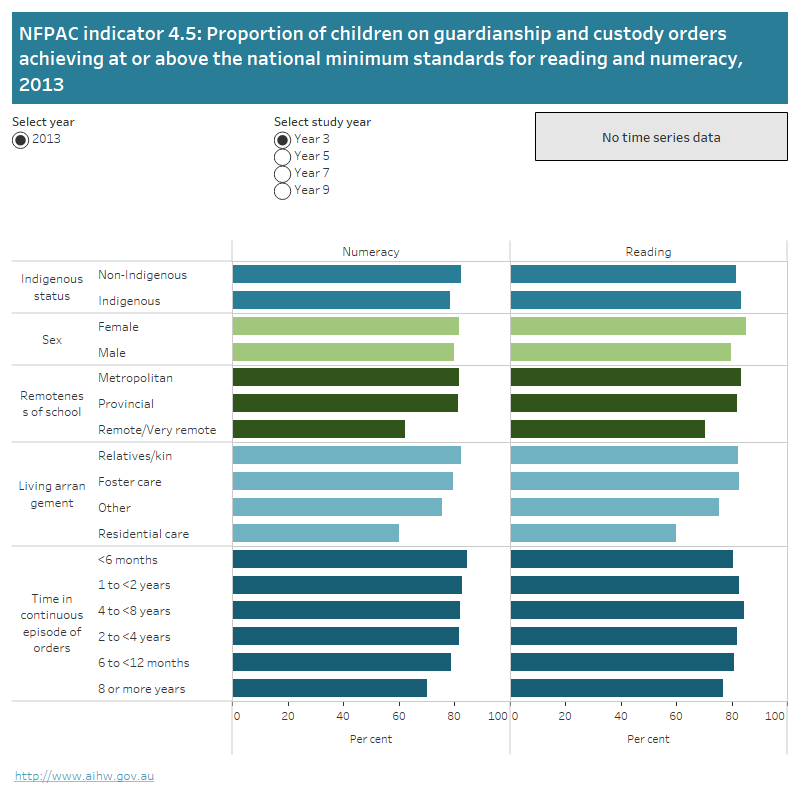4.5 Literacy & numeracy
This indicator measures the same outcome as NOOHCS Indicator 6.1 and therefore both indicators report the same numbers.
It is well known that education is important for the overall wellbeing of children. However, numerous studies have found that children in care have poorer education outcomes than other children.
This indicator uses results from the National Assessment Program – Literacy and Numeracy to assess if children in care are achieving at or above the national minimum standards for reading and numeracy.
Children ‘in care’ are those whose care arrangements have been ordered through the Children’s Court, where parental responsibility for the child or young person has been transferred to the Minister/Chief Executive.
Trend data: For all indicator displays, the yearly trend is limited to indicators with 3 or more years (including the current year) of comparable time series data. To see the trend click on “Yearly Trend” button on the display. Where 3 or more years of comparable data including the most recent year is not available, a “No time series data” message is shown on the display.
The horizontal bar graph shows the proportion of children on guardianship and custody orders achieving at or above the national minimum standards for reading and numeracy in 2013 by Indigenous status, sex, remoteness of school, living arrangement and time in continuous episode of orders. Data can be selected by study year (3, 5, 7 or 9).

Source: AIHW (2015) Educational outcomes for children in care: Linking 2013 child protection and NAPLAN data, AIHW, Australian Government.
See the supplementary data tables for further information and footnotes about these data.
Indicator technical specifications
The information below provides technical specifications for the summary indicator data presented in the quick reference guide.
For Year 3, 5, 7, 9
|
Definition | Data source |
|---|---|---|
| Numerator |
|
a, b. AIHW Linked child protection and NAPLAN dataset |
| Denominator |
|
a, b. AIHW Linked child protection and NAPLAN dataset |
Explanatory notes
Australian national minimum standards for literacy and numeracy have been developed as part of the National Assessment Program – Literacy and Numeracy (NAPLAN).
The AIHW dataset was created through the linkage of data from the Child Protection National Minimum Data Set (CP NMDS) and the National Assessment Program – Literacy and Numeracy (NAPLAN), for available states/territories. Further information is provided in the AIHW 2015 report Educational outcomes for children in care: linking 2013 child protection and NAPLAN data.
NAPLAN data are only available for selected school year levels. The NAPLAN tests are conducted in May each year for all students across Australia in Years 3, 5, 7 and 9, on the assessment domains of reading, writing, spelling, grammar and punctuation, and numeracy.
Children ‘in care’ are defined as children whose care arrangements have been ordered through the Children’s Court, where parental responsibility for the child or young person has been transferred to the Minister/Chief Executive. Only children who were ‘in care’ at the time of NAPLAN testing (for example, 14–16 May 2013) are included in the data source.
For both sub-measures, the numerator includes the assessed students who achieved the national minimum standard (i.e. ‘present’ students whose test score was at or above the national minimum standard). The denominator includes all assessed students (i.e. all ‘present’ and ‘exempt’ students); exempt students are deemed to be below the national minimum standard. Absent and withdrawn students are excluded from the calculations.


